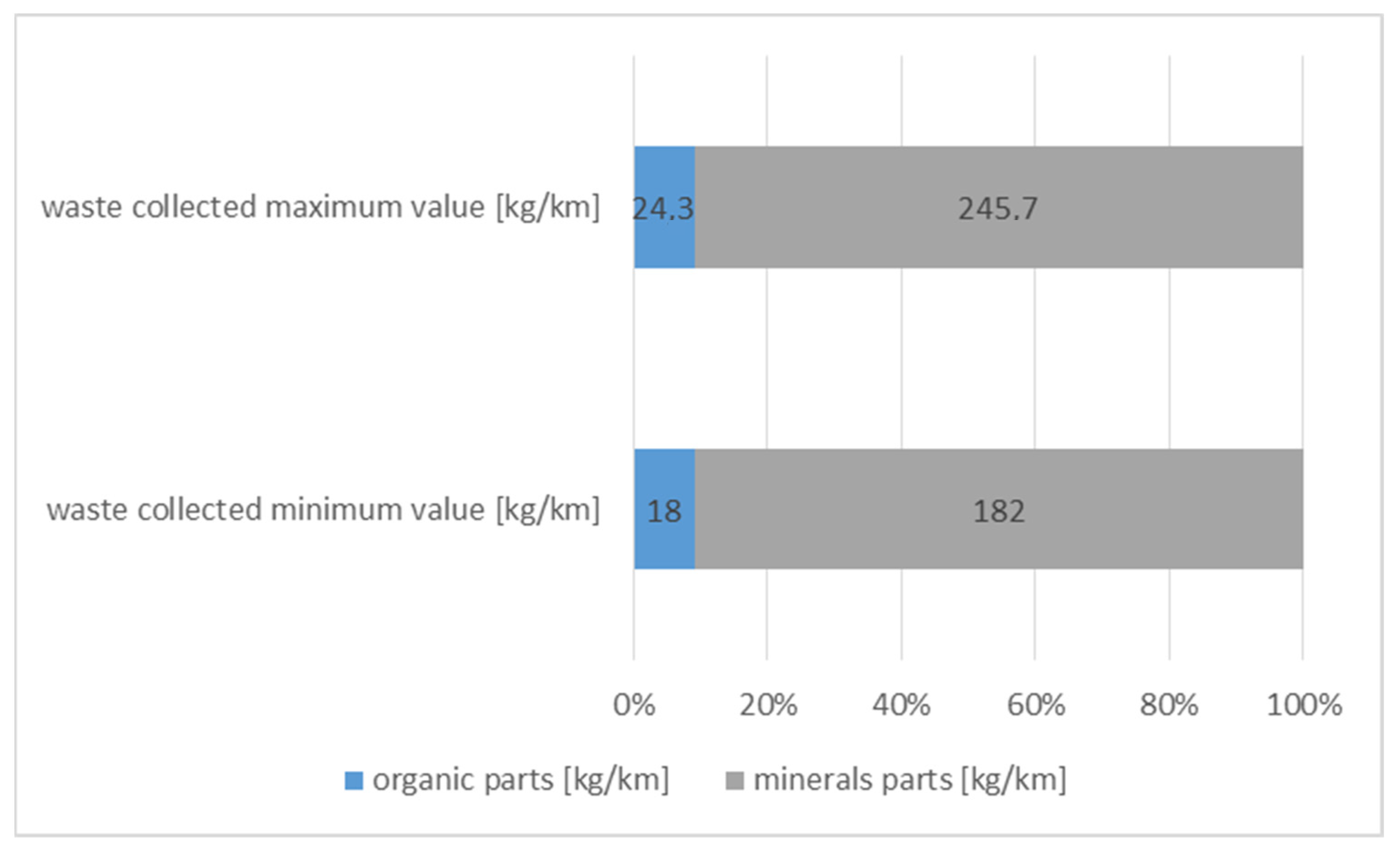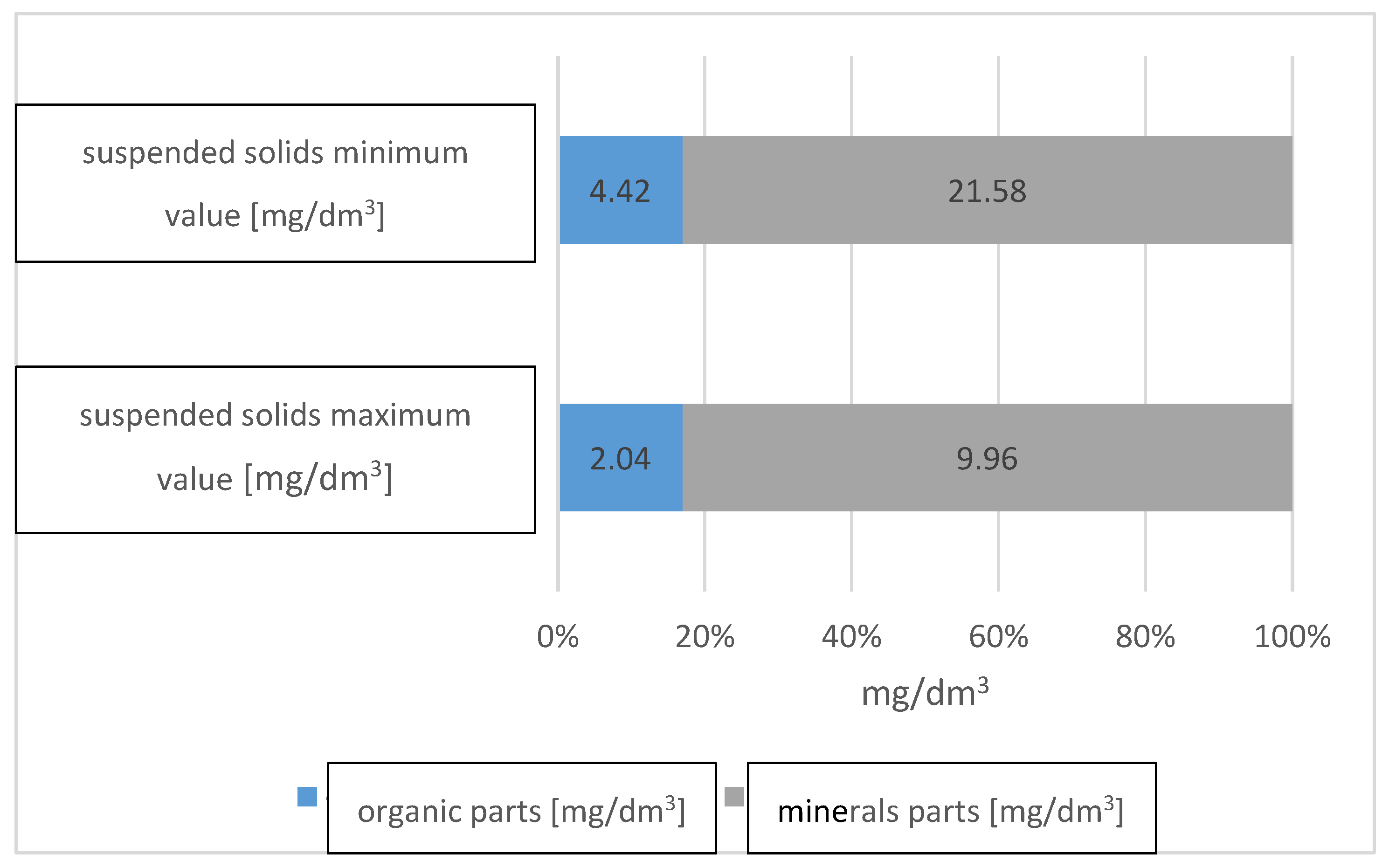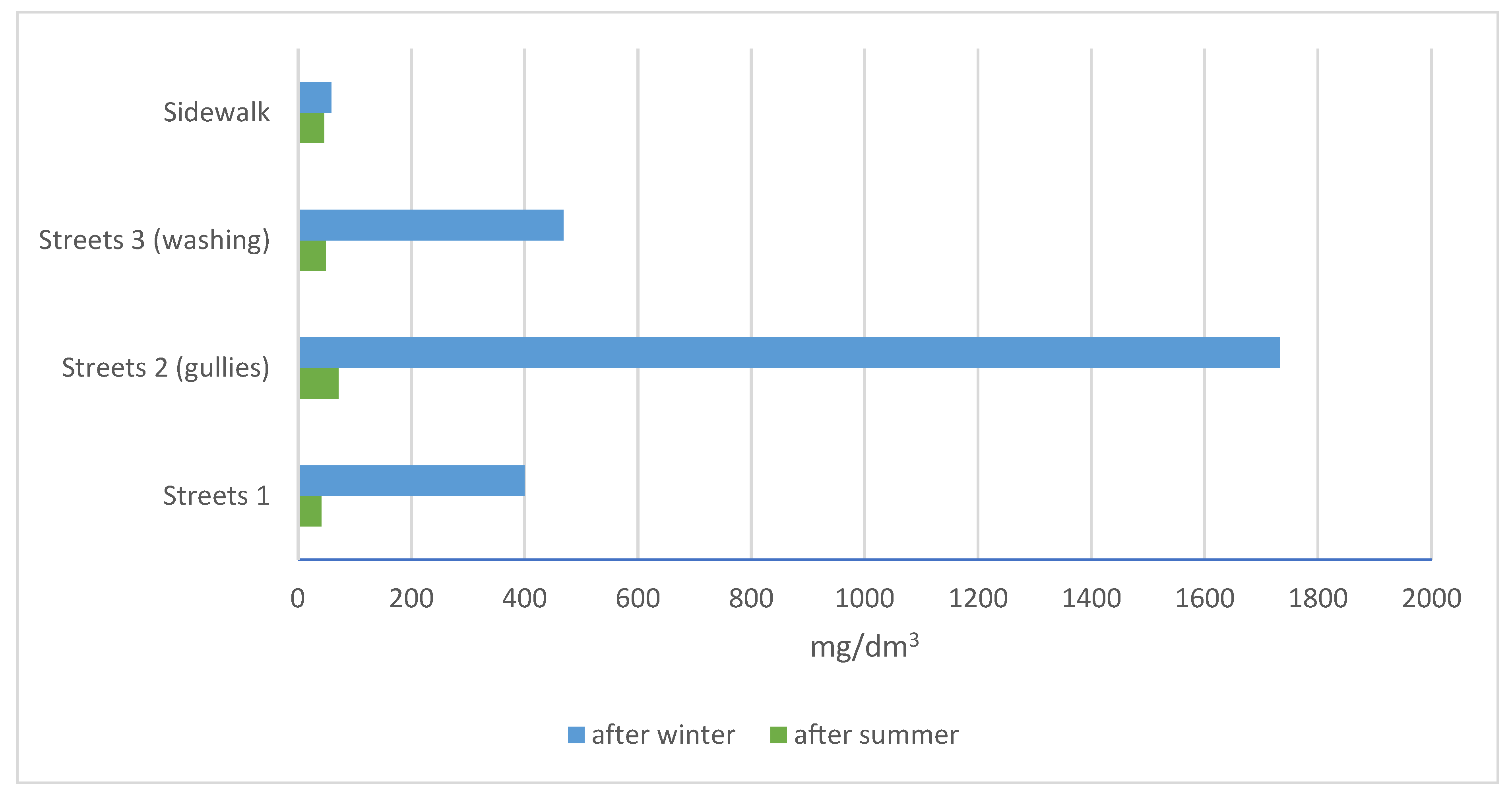Determining the Effectiveness of Street Cleaning with the Use of Decision Analysis and Research on the Reduction in Chloride in Waste
Abstract
:1. Introduction
2. Chlorides and Their Impact on the Environment
3. Proposed Research Methodology
- a selection of test times and places, and a selection of sampling locations;
- laboratory testing of the samples, processing of the test results, and conclusions from the analytical tests; and
- a decision analysis and a selection of the system of treatments and removal of chlorides from the environment according to the following scheme: development of treatment options taking into account environmental quality studies with costs, proposal of conditions and limitations to the decision analysis, and identification of the most beneficial scenario taking into account environmental and economic factors.
4. Description and Results of Analytical Research
5. Results of Decision Analysis Using Multi-Criteria Analysis
- Amount of waste collected cumulatively in consecutive days of cleaning measured in kg/technological km;
- Amount of wastewater from street cleaning, cumulatively over successive days of street cleaning, measured in l/technological km;
- Reduction in suspended solids calculated as the result of the difference between the first (on the first day) and the last street washing (on the last day);
- Costs of each consecutive street cleaning activity, including equipment maintenance costs, water and fuel consumption, employee costs, and environmental emissions fees, that were estimated on the basis of actual measurements; and
- Reduction in chloride content calculated as the difference in chloride content between the first and last days of cleaning and washing.
- It is possible to select a cleaning scenario for a selected area using a decision analysis, proposing environmental and economic criteria for evaluation.
- According to the results of the calculations presented in Table 3, it can be seen that the most frequently selected scenario is Scen2 with sweeping and one-day street washing.
- Scen4, sweeping and washing the street in a 5-day system, is selected as the most advantageous eight times (including two times while the weight of the cost criterion was reduced in relation to environmental criteria), which allows us to conclude that costs should be taken into account and calculated in the selection and analysis of cleaning strategies each time.
- Scen1 (sweeping only) and Scen4 (where the cleaning and washing process is the longest 5-day process) are selected as the least favorable in a significant number of cases; therefore, it can be said that, by balancing the economic and ecological effects, a scenario that allows for an observance of the principles of sustainable development is selected.
- This method gives the possibility of additional weighting of the criteria by using the α exponent in formula (2). This exponent allows for additional weighting of each deviation from the ideal point in proportion to their value. The larger the value of α is, the greater the importance of large deviations of the strategy from the ideal point. For α = ∞, scenario 2 is always selected as the most favorable.
6. Conclusions
- The results of this research carried out in a medium city show how much chloride is present in sweepings. The diversification of sampling locations allowed us to determine where pollutants accumulate. These differences are very significant and amount to almost 1050 mg/dm3 in the period after winter between the place of sampling near the sewage gully and the roadway. Such a high concentration of chlorides in the sweepings deposited in the landfill in large quantities can cause an increase in the salinity of the landfill leachate, which in turn affects the prolonged decomposition of matter, the formation of biogas, and the possibility of salinization of groundwater and impede biological processes in sewage-treatment plants.
- The selection of a cleaning strategy with a particular emphasis on chloride reduction in this region is a difficult decision task that must take into account various, often conflicting goals and objectives, and socioeconomic interests. The measuring criteria defined allowed us to establish a quantitative and objectified evaluation of the performance of such a system. The proposed methodology provides the possibility of a quantitative; multifaceted; and at the same time, objectified evaluation of scenario solutions, replacing intuitive evaluations or those requiring expert opinions used so far. In the proposed example, Scen2, which includes sweeping and one-time street cleaning in a 1-day system, was selected as the most beneficial.
- The proposed methodology allows us to evaluate the system on an ongoing basis in accordance with the requirements of environmental management even if the objective or conditions in the region change.
Author Contributions
Funding
Institutional Review Board Statement
Informed Consent Statement
Data Availability Statement
Conflicts of Interest
References
- COMMISSION DECISION of 18 December 2014 Amending Decision 2000532EC on the List of Waste Pursuant to Directive 200898EC of the European Parliament and of the Council.Pdf. Available online: https://eur-lex.europa.eu/legal-content/EN/TXT/?uri=CELEX:32014D0955 (accessed on 27 February 2022).
- Alwaeli, M. End-of-Life Vehicles Recovery and Recycling and the Route to Comply with EU Directive Targets. Environ. Prot. Eng. 2016, 42, 191–202. [Google Scholar] [CrossRef]
- Generowicz, A.; Wassilkowska, A.; Kryłów, M. Qualitative composition of waste from street cleaning on the example of research carried out in Krakow. Przemysl. Chem. 2020, 99, 1312–1314. [Google Scholar] [CrossRef]
- Gronba-Chyła, A.; Generowicz, A.; Kramek, A. Using Selected Types of Waste to Produce New Light Ceramic Material. Pol. J. Environ. Stud. 2021, 30, 2073–2083. [Google Scholar] [CrossRef]
- Gronba-Chyła, A.; Generowicz, A. Municipal waste fraction below 10 mm and possibility of its use in ceramic building materials. Przem. Chem. 2020, 99, 1318–1321. [Google Scholar] [CrossRef]
- Norman, M.; Johansson, C. Studies of Some Measures to Reduce Road Dust Emissions from Paved Roads in Scandinavia. Atmos. Environ. 2006, 40, 6154–6164. [Google Scholar] [CrossRef]
- AIRUSE. AIRUSE LIFE 11 ENV/ES/584 the Scientific Basis of Street Cleaning Activities as Road Dust Mitigation Measure; AIRUSE: Leiden, The Netherlands, 2013. [Google Scholar]
- Vaze, J.; Chiew, F. Experimental Study of Pollutant Accumulation on an Urban Road Surface. Urban Water 2002, 4, 379–389. [Google Scholar] [CrossRef]
- Aldrin, M.; Hobæk Haff, I.; Rosland, P. The Effect of Salting with Magnesium Chloride on the Concentration of Particular Matter in a Road Tunnel. Atmos. Environ. 2008, 42, 1762–1776. [Google Scholar] [CrossRef]
- Chang, Y.-M.; Chou, C.-M.; Su, K.-T.; Tseng, C.-H. Effectiveness of Street Sweeping and Washing for Controlling Ambient TSP. Atmos. Environ. 2005, 39, 1891–1902. [Google Scholar] [CrossRef]
- Amato, F.; Querol, X.; Alastuey, A.; Pandolfi, M.; Moreno, T.; Gracia, J.; Rodriguez, P. Evaluating Urban PM10 Pollution Benefit Induced by Street Cleaning Activities. Atmos. Environ. 2009, 43, 4472–4480. [Google Scholar] [CrossRef]
- Amato, F.; Querol, X.; Johansson, C.; Nagl, C.; Alastuey, A. A Review on the Effectiveness of Street Sweeping, Washing and Dust Suppressants as Urban PM Control Methods. Sci. Total Environ. 2010, 408, 3070–3084. [Google Scholar] [CrossRef]
- Acosta, J.A.; Gabarrón, M.; Faz, A.; Martínez-Martínez, S.; Zornoza, R.; Arocena, J.M. Influence of Population Density on the Concentration and Speciation of Metals in the Soil and Street Dust from Urban Areas. Chemosphere 2015, 134, 328–337. [Google Scholar] [CrossRef] [PubMed]
- Sobiecka, E. Thermal and Physicochemical Technologies Used in Hospital Incineration Fly Ash Utilization before Landfill in Poland. J. Chem. Technol. Biotechnol. 2016, 91, 2457–2461. [Google Scholar] [CrossRef]
- Fergusson, J.E.; Ryan, D.E. The Elemental Composition of Street Dust from Large and Small Urban Areas Related to City Type, Source and Particle Size. Sci. Total Environ. 1984, 34, 101–116. [Google Scholar] [CrossRef]
- Qiao, X.-X.; Dong, Y.; Lei, Y.-S.; Zhou, L.-X.; Liu, F.-W. Effect of Chloride Ions on Biological Oxidation of Pyrite and the Biomineralization Behavior in Wastewater System. Chin. J. Ecol. 2018, 37, 1685–1692. [Google Scholar] [CrossRef]
- Gluba, T.; Olejnik, T.R.; Obraniak, A. Technology for producing washing agent in continuous process. Przemysl. Chem. 2015, 94, 1370–1374. [Google Scholar] [CrossRef]
- Zhou, Y.; Huang, M.; Deng, Q.; Cai, T. Combination and Performance of Forward Osmosis and Membrane Distillation (FO-MD) for Treatment of High Salinity Landfill Leachate. Desalination 2017, 420, 99–105. [Google Scholar] [CrossRef]
- Ciuła, J. Modelling the migration of anthropogenic pollution from active municipal landfill in groundwaters. Archit. Civ. Eng. Environ. 2021, 14, 81–90. [Google Scholar] [CrossRef]
- Generalna Dyrekcja Dróg Krajowych i Autostrad—Generalna Dyrekcja Dróg Krajowych i Autostrad—Portal Gov.pl. Available online: https://www.gov.pl/web/gddkia (accessed on 19 March 2022).
- Ordinance of the Minister of Environment of 27 October 2005 on the Types and Conditions of Using Means That Can Be Used on Public Roads, Streets and Squares. J. Laws 2005, 230, 1960.
- Findlay, S.E.G.; Kelly, V.R. Emerging Indirect and Long-Term Road Salt Effects on Ecosystems. Ann. N. Y. Acad. Sci. 2011, 1223, 58–68. [Google Scholar] [CrossRef]
- Mazur, N. Effects of Road Deicing Salt on the Natural Environment. Eng. Environ. Prot. 2015, 18, 449–458. (In Polish) [Google Scholar]
- Bäckström, M.; Karlsson, S.; Bäckman, L.; Folkeson, L.; Lind, B. Mobilisation of Heavy Metals by Deicing Salts in a Roadside Environment. Water Res. 2004, 38, 720–732. [Google Scholar] [CrossRef] [PubMed]
- Regulation of the Minister of Maritime Affairs and Inland Navigation of 11 October 2019 on the Criteria and Method of Assessing the Status of Groundwater Bod(Dz.U.2019.2148). Available online: https://isap.sejm.gov.pl/isap.nsf/DocDetails.xsp?id=WDU20190000868 (accessed on 27 February 2022).
- Regulation of the Minister of Environment of 21 July 2016 on the Method of Classification of the State of Surface Water Bodies and Environmental Quality Standards for Priority Substances (Journal of Laws 2016, 1187). Available online: https://isap.sejm.gov.pl/isap.nsf/DocDetails.xsp?id=WDU20160001187 (accessed on 27 February 2022).
- Safdar, H.; Amin, A.; Shafiq, Y.; Ali, A.; Yasin, R.; Sarwar, M.I. A Review: Impact of Salinity on Plant Growth. Nat. Sci. 2019, 1, 34–40. [Google Scholar] [CrossRef]
- Kuosa, H.; Ferreira, R.M.; Holt, E.; Leivo, M.; Vesikari, E. Effect of Coupled Deterioration by Freeze–Thaw, Carbonation and Chlorides on Concrete Service Life. Cem. Concr. Compos. 2014, 47, 32–40. [Google Scholar] [CrossRef]
- Czajka, A. Control of the State of the Soil Environment in the Vicinity of Communication Infrastructure. Eliksir 2017, 2, 8–12. (In Polish) [Google Scholar]
- Sławiński, J.; Gołąbek, E.; Senderak, G. Influence of transport pollution on soil and cultivated vegetation of the wayside. Inż. Ekol. 2014, 40, 137–144. [Google Scholar] [CrossRef]
- Casey, R.; Lev, S.; Snodgrass, J. Stormwater Ponds as a Source of Long-Term Surface and Ground Water Salinisation. Urban Water J. 2013, 10, 145–153. [Google Scholar] [CrossRef]
- Satterstrom, F.; Kiker, G.; Batchelor, C.; Bridges, T.; Ferguson, E.; Linkov, I.; Satterstrom, F.K.; Kiker, G.; Batchelor, C.; Bridges, T.; et al. From Comparative Risk Assessment to Multi-Criteria Decision Analysis and Adaptive Management: Recent Developments and Applications. Environ. Int. 2007, 32, 1072–1093. [Google Scholar] [CrossRef]
- Wilson, E.J.; McDougall, F.R.; Willmore, J. Euro-Trash. Searching Europe for a More Sustainable Approach to Waste Management. Resour. Conserv. Recycl. 2001, 31, 327–346. [Google Scholar] [CrossRef]
- Morrissey, A.J.; Browne, J. Waste Management Models and Their Application to Sustainable Waste Management. Waste Manag. 2004, 24, 297–308. [Google Scholar] [CrossRef]
- Li, Y.P.; Huang, G.H. An Inexact Two-Stage Mixed Integer Linear Programming Method for Solid Waste Management in the City of Regina. J. Environ. Manag. 2006, 81, 188–209. [Google Scholar] [CrossRef]
- Aragonés-Beltrán, P.; Mendoza-Roca, J.; Bes-Piá, A.; García-Melón, M.; Parra-Ruiz, E. Application of Multicriteria Decision Analysis to Jar-Test Results for Chemicals Selection in the Physical-Chemical Treatment of Textile Wastewater. J. Hazard. Mater. 2009, 164, 288–295. [Google Scholar] [CrossRef] [PubMed]
- Garfí, M.; Tondelli, S.; Bonoli, A. Multi-Criteria Decision Analysis for Waste Management in Saharawi Refugee Camps. Waste Manag. 2009, 29, 2729–2739. [Google Scholar] [CrossRef] [PubMed]
- Shmelev, S.; Powell, J. Ecological–Economic Modelling for Strategic Regional Waste Management Systems. Ecol. Econ. 2006, 59, 115–130. [Google Scholar] [CrossRef]
- Vego, G.; Kučar-Dragičević, S.; Koprivanac, N. Application of Multi-Criteria Decision-Making on Strategic Municipal Solid Waste Management in Dalmatia, Croatia. Waste Manag. 2008, 28, 2192–2201. [Google Scholar] [CrossRef]
- Cossu, R. Waste Management, Energy Production, Healthcare: Amazing Similarities. Waste Manag. 2011, 31, 1671–1672. [Google Scholar] [CrossRef]
- Generowicz, A.; Kowalski, Z.; Kulczycka, J.; Makara, A. Multi-Criteria Analysis for Optimization of Sodium Chromate Production from Chromic Waste. Soil Air Water 2011, 39, 688–696. [Google Scholar] [CrossRef]
- Generowicz, A.; Gaska, K.; Hajduga, G. Multi-Criteria Analysis of the Waste Management System in a Metropolitan Area. In Proceedings of the 10th Conference on Interdisciplinary Problems in Environmental Protection and Engineering EKO-DOK 2018, Polanica-Zdroj, Poland, 16–18 April 2018; Volume 44, p. 43. [Google Scholar] [CrossRef] [Green Version]
- Generowicz, A.; Kulczycka, J.; Kowalski, Z.; Banach, M. Assessment of Waste Management Technology Using BATNEEC Options, Technology Quality Method and Multi-Criteria Analysis. J. Environ. Manag. 2011, 92, 1314–1320. [Google Scholar] [CrossRef]
- Gaska, K.; Generowicz, A. SMART Computational Solutions for the Optimization of Selected Technology Processes as an Innovation and Progress in Improving Energy Efficiency of Smart Cities—A Case Study. Energies 2020, 13, 3338. [Google Scholar] [CrossRef]
- Ciuła, J.; Kozik, V.; Generowicz, A.; Gaska, K.; Bak, A.; Paździor, M.; Barbusiński, K. Emission and Neutralization of Methane from a Municipal Landfill-Parametric Analysis. Energies 2020, 13, 6254. [Google Scholar] [CrossRef]
- Qureshi, M.E.; Harrison, S.R.; Wegener, M.K. Validation of Multicriteria Analysis Models. Agric. Syst. 1999, 62, 105–116. [Google Scholar] [CrossRef]
- Polish Standard PN-93/Z-15008/01; Municipal Solid Waste. Testing of Fuel Properties. General Provisions. Polish Committee for Standardization: Płock, Poland, 1993.
- Polish Standard PN-93/C-87071; Final (Laboratory) Sample. General Guidelines. Polish Committee for Standardization: Płock, Poland, 1993.
- Polish Standard PN-ISO 9297:1994; Water Quality—Determination of chlorides—Method of Titration with Silver Nitrate in the Presence of chromate As Indicator (Mohr Method). Polish Committee for Standardization: Płock, Poland, 1994.



| Site | Chloride Content in Street Cleaning Wastewater (mg/dm3) after Summer | Chloride Content in Street Cleaning Wastewater (mg/dm3) after Winter | ||
|---|---|---|---|---|
| Minimum Value | Maximum Value | Minimum Value | Maximum Value | |
| Street 1 | 29.3 | 41.4 | 321.6 | 399.8 |
| Street 2 (gullies) | 45.6 | 71.9 | 1201.4 | 1732.8 |
| Street 3 (washing) | 38.3 | 49.3 | 436.3 | 468.5 |
| Sidewalk | 25.8 | 46.2 | 45.9 | 59.2 |
| Criteria | Unit | Sweeping | Sweeping + Washing 1 Day | Sweeping + Washing 2 Days | Sweeping + Washing 5 Days |
|---|---|---|---|---|---|
| Scen1 | Scen2 | Scen3 | Scen4 | ||
| waste amount | kg/km | 200 | 200 | 250 | 270 |
| amount of wastewater from street cleaning | l/km | 0 | 25 | 50 | 75 |
| reduction in suspended solids on subsequent cleaning days | 0 | 30 | 45 | 67 | |
| costs | euro/km | 3 | 5 | 7.5 | 10 |
| chloride content reduction | 0 | 56 | 78 | 90 |
| Validity of the Criteria | Ranking of Scenarios | ||
|---|---|---|---|
| α = 1 | α = 2 | α = ∞ | |
| 1:1:1:1:1 | Scen2→Scen3→Scen4→Scen1 | Scen2→Scen3→Scen4→Scen1 | Scen2⟷Scen3→Scen1⟷Scen4 |
| 2:1:1:1:1 | Scen3→Scen2→Scen4→Scen1 | Scen2→Scen3→Scen4→Scen1 | Scen2⟷Scen3→Scen1⟷Scen4 |
| 10:1:1:1:1 | Scen4→Scen3→Scen2→Scen1 | Scen3→Scen4→Scen2→Scen1 | Scen2⟷Scen3→Scen1⟷Scen4 |
| 1:2:1:1:1 | Scen2→Scen1→Scen3→Scen4 | Scen2→Scen1→Scen3→Scen4 | Scen2⟷Scen3→Scen1 |
| 1:10:1:1:1 | Scen1→Scen2→Scen3→Scen4 | Scen1→Scen2→Scen3→Scen4 | Scen2⟷Scen3→Scen1 |
| 1:1:2:1:1 | Scen4→Scen3→Scen2→Scen1 | Scen3→Scen2→Scen4→Scen1 | Scen2⟷Scen3→Scen4 |
| 1:1:10:1:1 | Scen4→Scen3→Scen2→Scen1 | Scen4→Scen3→Scen2→Scen1 | Scen2⟷Scen3→Scen4 |
| 1:1:1:2:1 | Scen2→Scen1→Scen3→Scen4 | Scen2→Scen1→Scen3→Scen4 | Scen2⟷Scen3→Scen1 |
| 1:1:1:10:1 | Scen1→Scen2→Scen3→Scen4 | Scen1→Scen2→Scen3→Scen4 | Scen2⟷Scen3→Scen1 |
| 1:1:1:1:2 | Scen3→Scen4→Scen2→Scen1 | Scen3→Scen2→Scen4→Scen1 | Scen2⟷Scen3→Scen4 |
| 1:1:1:1:10 | Scen4→Scen3→Scen2→Scen1 | Scen4→Scen3→Scen2→Scen1 | Scen2⟷Scen3→Scen4 |
| 2:2:2:1:2 | Scen4→Scen3→Scen2→Scen1 | Scen2→Scen3→Scen4→Scen1 | Scen2⟷Scen3 |
| 10:10:10:1:10 | Scen4→Scen3→Scen2→Scen1 | Scen3→Scen2→Scen4→Scen1 | Scen2⟷Scen3 |
Publisher’s Note: MDPI stays neutral with regard to jurisdictional claims in published maps and institutional affiliations. |
© 2022 by the authors. Licensee MDPI, Basel, Switzerland. This article is an open access article distributed under the terms and conditions of the Creative Commons Attribution (CC BY) license (https://creativecommons.org/licenses/by/4.0/).
Share and Cite
Gronba-Chyła, A.; Generowicz, A.; Kwaśnicki, P.; Cycoń, D.; Kwaśny, J.; Grąz, K.; Gaska, K.; Ciuła, J. Determining the Effectiveness of Street Cleaning with the Use of Decision Analysis and Research on the Reduction in Chloride in Waste. Energies 2022, 15, 3538. https://doi.org/10.3390/en15103538
Gronba-Chyła A, Generowicz A, Kwaśnicki P, Cycoń D, Kwaśny J, Grąz K, Gaska K, Ciuła J. Determining the Effectiveness of Street Cleaning with the Use of Decision Analysis and Research on the Reduction in Chloride in Waste. Energies. 2022; 15(10):3538. https://doi.org/10.3390/en15103538
Chicago/Turabian StyleGronba-Chyła, Anna, Agnieszka Generowicz, Paweł Kwaśnicki, Dawid Cycoń, Justyna Kwaśny, Katarzyna Grąz, Krzysztof Gaska, and Józef Ciuła. 2022. "Determining the Effectiveness of Street Cleaning with the Use of Decision Analysis and Research on the Reduction in Chloride in Waste" Energies 15, no. 10: 3538. https://doi.org/10.3390/en15103538
APA StyleGronba-Chyła, A., Generowicz, A., Kwaśnicki, P., Cycoń, D., Kwaśny, J., Grąz, K., Gaska, K., & Ciuła, J. (2022). Determining the Effectiveness of Street Cleaning with the Use of Decision Analysis and Research on the Reduction in Chloride in Waste. Energies, 15(10), 3538. https://doi.org/10.3390/en15103538










